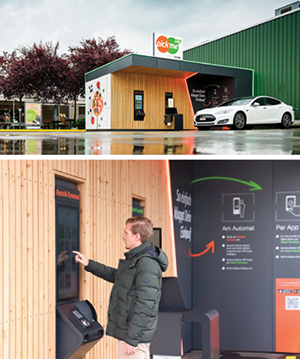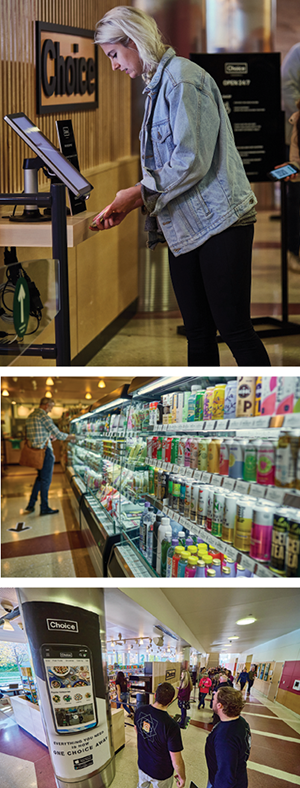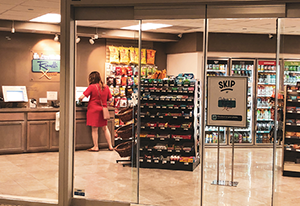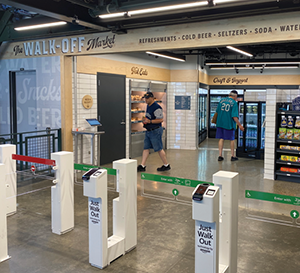 migrolino
migrolino
Fifteen years ago, eyes would have rolled if you were told that the future of successful convenience store retailing would rest not on what shoppers could purchase but how they could purchase. It’s a tech-driven economy, and consumers are firmly in control.
The shift has been gradual but unwavering. Ten years ago, in the NACS Magazine article “Big Data. Big Results.” (May 2013), NACS reported on the growth of artificial intelligence (AI)-fueled analytics capabilities and the opportunities available for convenience store operators. “The Big Data approach is not a trending fad but the evolution of a culture that has placed the consumer, not the retailer in control. And how you respond to that dynamic will likely affect your long-term success as you battle for market share of your corner and beyond.”
Five years later in “What’s Minding the Store” (October 2018), NACS Magazine highlighted preliminary tests on robot waiters and automated burger flippers. “Yes, the future is here,” we wrote. “And if not yet on your street corner, it’s fast approaching.”
As you probably have noticed, the future has arrived, and it is on your street corner. And battling for market share has never been fiercer. While there’s no one-size-fits-all solution to achieving success, some retailers are turning to advanced automation to strengthen their bottom line.
We’ve been continuously looking to reduce friction through the ordering and checkout process for several years.”
A WORK IN PROGRESS
You’ve seen automation evolving, of course, at supermarkets throughout the country. Self-checkout lines have become ubiquitous, a modest retailer control concession that is the baseline consumer expectation today.
According to data from Catalina, self-checkout lanes have increased 10% over the past five years to comprise 38% of lanes in grocery chains, “an effort to offset shrinking margins from inflationary labor costs, respond to social distancing protocols ...” Among convenience retailers surveyed by NACS, 41% indicated that they planned to offer frictionless/cashierless checkout in 2022, according to the NACS Building Convenience Retail Success Through Technology survey.
Then there’s full automation.
When it became operational roughly six years ago, Amazon’s cashierless store, Amazon Go, was an industry curiosity—No cashiers? No checkout lines?—that has since expanded, albeit at a trickle (by Amazon’s standards). As of December 2022, the company was operating 30 stores with its Just Walk Out technology, the majority (24) in Chicago, New York, San Francisco and Seattle.
Amazon’s technology has spawned competitive technology from the likes of Standard AI and others that convenience store retailers are adopting. Is it overreach for an industry built upon durable, local relationships? Or a necessary evolution to withstand eroding margins and shrinking market share? Let’s take a closer look.
Our building store used to be open from 6 a.m. to 6 p.m., but with self-serve, we can operate 24/7.”
THE CASE FOR AUTOMATION
Let’s concede for the moment that in-store automation technology is reliable, the how-to consideration that’s better left for other analyses. The key question, once you’re sold on the technology, is why? And for that, we look to shopper attitudes.
“Consumers like in-store automation as an enabler to improve the store experience,” reports the Capgemini Research Institute, especially after a pandemic that shifted shopping behaviors away from in-store experiences. The technology is notably engaging for Gen Z and millennials, 64% of whom have visited automated stores, versus 50% for the general population. And if you get the technology right, the experience is shopper-sticky: 59% of shoppers overall who had a positive experience at an automated store would shift their loyalties to that store, a number that jumps to 67% for millennials.
Convenience is a driving factor in consumers’ adoption of store automation. U.K. retailer Marks & Spencer was an early adopter of cashierless shopping, launching its Mobile, Pay, Go app in late 2018. “Our customers—especially those who come to us for lunch—are so busy, any tech that can speed up the shopping experience is a massive benefit to them,” the company said, noting that the technology quickly captured 20% of its sales via its cashierless-enabled app.
When compared to stores that offer little to no automation, automated stores experienced an 11% sales lift among shoppers, as well as an 11% increase in trip frequency, the Capgemini research found.
Speaking at the 2022 NACS Convenience Summit Europe, Sebastian Becker, head of wholesale and logistics for Swiss-based retailer migrolino, outlined his company’s tech approach to convenience retailing, with a growth strategy that includes 24/7 automated format stores. The concept was a response to an EV charging partnership with Tesla, which wanted a store open around the clock. “[W]e [couldn’t] have a manned shop at this location, so this was our solution,” he said.
For migrolino, the primary consumer benefit for its unmanned store is one of convenience. “There are at least 100 different forms of [unattended retail] in Europe and unmanned public stores,” he said on a recent Shop Talk LIVE podcast, “and unmanned is not unmanned in many cases. But it’s a frictionless shopping experience [that wins consumers].”
Of course, the labor savings look good on any retailer’s bottom line, too, but winning customers is primarily about creating a favorable experience.
Unmanned is not unmanned in many cases.”
GIVE ME A BREAK
In addition to Amazon and migrolino, you’ve seen automated stores popping up in a variety of settings, each with their own motivations and customer challenges.
Aisle 24 is a Toronto-based retailer that automates the grocery shopping experience, launching its first cashierless store in 2016. For co-founder and CEO John Douang, the winning formula isn’t so much about technology as it is about understanding your customer. “We pride ourselves on being able to craft a product offering to the demographics in the particular community in which an Aisle 24 location is present,” he told Retail TouchPoints. The approach is critical to “meet[ing] the locals’ needs and wants.”
For Douang, the cashierless business model was one of necessity. “If [I] wanted to take a break or a vacation, [I] had to shut the store,” he said. “That meant lost revenue and lost income. Moving into cashierless, touchless and cashless was the natural progression of the retail industry.”
His younger customers have taken to the format enthusiastically. “Gen Z and millennial consumers are the largest spenders,” he said. “As Gen Z gets older, those consumers are going to control a bigger market spend. Their expectations are very aligned with the digital world. Having a traditional experience in a retail environment doesn’t really align with their demands.”
IN THE U.S.
Closer to home, NACS Magazine spoke with two U.S.-based convenience retailers about their experience with automated c-stores.
Choice Market
 Choice Market
Choice Market
Long a proponent of using technology to enhance the customer experience, Mike Fogarty, founder and CEO of Denver-based Choice Market, launched a proprietary digital platform in 2019 that offered, among other things, 45-minute delivery turnarounds on customer orders. “The primary goals are to enhance the digital customer experience, to reduce our delivery expense and drive customer loyalty,” Fogarty said in announcing the platform’s rollout.
While the platform was a notable milestone for the company as it established itself among the area’s Gen Z and millennial demographics, Fogarty’s tech work was just beginning.
“We’ve been continuously looking to reduce friction through the ordering and checkout process for several years,” he said, a search that brought him in 2021 to the launch of the company’s Choice Now mobile check-in and cashierless checkout technology.
Unveiled at the company’s 5,000-square-foot Bannock Street store, Choice Now offers shoppers a cashierless checkout option—but only if they want it. “We like to provide options to our shoppers, and the larger format store lends itself to multiple ways to check out.”
But when the company decided to build a 400-square-foot minimart on a Denver medical campus in late 2022, Fogarty decided the time was right to let Choice Now stand on its own as the store’s lone checkout technology.
“The medical community and CU students work tirelessly to serve the greater Denver community,” Fogarty said at the store’s launch. “We couldn’t be more excited to provide these time-strapped first responders, students, patients and their families with high quality groceries and fresh meals 24/7/365.”
With roughly 1,000 SKUs decorating a space that was previously a hallway, Fogarty said the factors were ideal to test Choice Now as the store’s exclusive operating option.
The store’s first two months have produced “data that is really promising,” Fogarty said. “It’s a low margin business, and this is an efficient way for us to distribute product.”
Fogarty said that each retailer would have to evaluate a fully automated store model based on their individual circumstances. “For our smaller format store, it’s about efficiency and convenience, placing products in places where people work or travel and there’s a density for walking traffic,” he said.
While labor reduction was not a primary consideration, Fogarty said the store has reduced staffing by 80 to 90% from a traditional store, though he cautions that alcohol is an outlier. “That still requires a person to be on-site.”
As for Choice’s customers, “they really love the [fully automated format],” Fogarty said. “They love the convenience factor, and the feedback overall has been really strong.”
As a result, he intends to expand the concept in a hybrid model (cashier and cashierless options) to four of his company’s five stores. “In our larger stores, it’s less about labor reduction and more about extending operating hours and revenue growth,” he said, “while maximizing revenue per square foot.”
The landlord asked us if there was any way for us to remain open, and I told him I could do it only if we eliminated labor.”
Russell’s Xpress
Colorado-based Russell’s Xpress includes two unmanned stores, a model that the company has operated since 2015. Predating even Amazon Go, the unmanned concept was born out of necessity in one of the company’s high-rise office building locations.
“The building’s traffic pattern had changed, and we were about to close the location,” said Ray Huff, president of HJB Convenience Corp., which operates the Russell’s Convenience and Russell’s Xpress brands. “The landlord asked us if there was any way for us to remain open, and I told him I could do it only if we eliminated labor.”
They did eliminate labor. And they remained open. And things have been working ever since.
The concept is simple: Shoppers must be a member of the Russell’s Rewards Club, which assigns them a number. To enter the store (which remains otherwise locked), they enter the number on a keypad at the store’s entrance, which opens the door. Once inside a store, they shop, scan and pay for their selections on their own.
It’s an ideal concept for the building’s tenants, for whom weather often makes them captive consumers. “One of the beauties of being in high-rise office buildings is that we service that building, and if the weather gets bad, be it rain, hail, sleet or snow, Russell’s is still there. And rather than office customers spreading out and going into the street, they all come to us.”
 Russell's Xpress
Russell's Xpress
It’s a format that has also proven valuable over the past few years, as the pandemic hit the company’s operations especially hard. “Before the pandemic, we had 24 stores, and now we have 11,” Huff said. “Traffic patterns have changed, and people are not returning to downtown areas to work.”
Huff said while the concept works well now for his customers, it’s not necessarily for everyone. “You have to know your customer,” he said. “What drove us to self-serve is that we’re in high rises, and everybody comes down between 6 and 9 and 11 and 1. It helps us better handle the traffic.”
In the meantime, the switch has produced unexpected results. “Our building store used to be open from 6 a.m. to 6 p.m., but with self-serve, we can operate 24/7. We’ve picked up sales that we didn’t get in the past.”
And while Huff worried that unmanned stores might produce an increase in theft, the opposite has occurred. “Our steal actually has gone down,” he said. “While theft industry-wide is maybe 2%, it’s one-tenth of that in our unmanned stores,” he said.
LOOKING AHEAD
While technology can generate profits and engage digital-savvy customers, don’t expect to instantly win over customers. “You have to have an in-store ambassador to make sure things go well,” Huff said. “Someone to teach people how the system works until they’re comfortable with things.”
But if it makes sense for your demographic, it could be an important component in your company’s overall business strategy. “We’re going to lean into this format next year and beyond,” Fogarty said. “This is a key part of our growth.
He added: “It’s a sustainable, profitable business model in a low-margin business.”
Ideas 2 Go: Unmanned

NACS visited the Walk-Off Market at T-Mobile Park, home of the Seattle Mariners, for the 2022 Ideas 2 Go video series. Powered by Amazon’s Just Walk Out and Amazon One frictionless technology, the market helps speed baseball fans on their way so they can enjoy refreshments and the game without waiting in line. See video of the store in action at www.convenience.org/Ideas2Go.
And in 2019, Ideas 2 Go visited Russell’s Xpress in Denver, Colorado. The c-store stocks snacks, confections, beverages and general merchandise for grabbing and going—the perfect selection for office workers. Take a tour of the store at www.convenience.org/Ideas2Go.